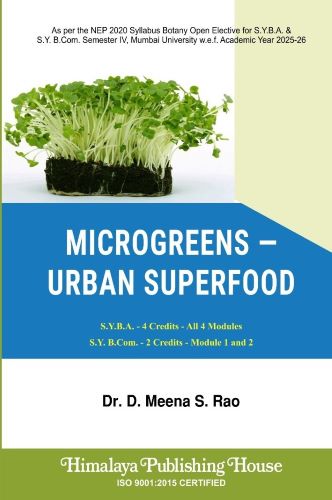In today’s fast-paced world, the growing concern for health, nutrition, and environmental sustainability has led to renewed interest in microgreens, tiny but mighty plants that pack immense flavour and nutrients. Once limited to gourmet kitchens, microgreens have now found their place in homes, restaurants, and urban gardens across the world.
This book, ‘Microgreens – Urban Superfood’, is thoughtfully designed to provide learners with a well-rounded understanding of this emerging field. Beginning with the basics, understanding what microgreens are, their evolution, and their significance in urban gardening, it gradually explores diverse aspects such as cultivation techniques, nutritional and medicinal value, and the practical process of growing them at home.
The modules delve into the wider applications of microgreens by highlighting their health benefits, culinary versatility, and their role in sustainable urban living. Learners are further encouraged to explore microgreens as a business opportunity, with guidance on entrepreneurship, branding, marketing, and the use of modern technologies like AI and automation.
An important feature of this book is its focus on communication skills, viz., designing advertisements and catchy jingles, presenting effective business pitches, and enabling learners to express their ideas with clarity and creativity.
Overall, it aims to blend scientific understanding with practical skills, entrepreneurial thinking, and sustainability awareness, empowering learners to see microgreens not just as a food product but as a pathway toward a healthier and greener future.
Contents –
Module 1: Introduction to Microgreens
1.1 Understanding Microgreens
– What are microgreens? Difference between sprouts, microgreens, and baby greens
– History and evolution of microgreens as a superfood
– Importance in urban and indoor gardening
1.2 Types of Microgreens, Nutritional and Medicinal Value
– Commonly grown microgreens (Mustard, fenugreek, spinach, radish, sunflower, basil, pea shoots)
– Indian vs. Exotic microgreens
– Nutritional benefits and medicinal value
1.3 Growing Microgreens at Home/On Small-Scale + Case Studies
– Materials needed (Seeds, trays, soil/coconut coir, water)
– Step-by-step process of growing microgreens indoors
– Troubleshooting common issues (mould, overwatering, poor growth)
Module 2: Applications, and Health Benefits
2.1 Microgreens and Health Benefits
– Nutritional comparison with mature plants
– Role of microgreens in immunity and detoxification
– Use of microgreens in traditional and modern diets
2.2 Culinary Uses of Microgreens
– Incorporating microgreens into daily meals (salads, smoothies, soups, garnishing)
– Microgreens in fine dining and gourmet cuisine
– Traditional Indian recipes using microgreens
2.3 Microgreens for Sustainable Living
– Urban farming and rooftop gardening with microgreens
– Reducing carbon footprint through homegrown food
– Role of microgreens in tackling food security issues
Module 3: Business Opportunities and Practical Skills of Microgreens
3.1 Entrepreneurship and Future Trends
– Small-scale business models and plans for microgreens farming
– Marketing strategies for selling microgreens
– Emerging trends: AI, automation, and smart farming of microgreens
3.2 Practical Skills and DIY Projects
– Designing a “Grow at Home” beginner’s kit
– Basic recipe creation using microgreens
– Branding: Create a name and label for your microgreens brand
3.3 Branding and Market Positioning
– Introduction to agricultural branding for smallscale growers
– Elements of a strong microgreen brand: name, logo, label, identity
– Sample case analysis: Successful microgreen startups
Module 4: Communication for Sustainable Microgreens
4.1 Microgreen Communication
– Introduction to microgreen communication
– Challenges in microgreen communication
– Strategies to mitigate challenges to microgreen communication
4.2 Advertisement Design and Jingle Creation
– Introduction to product promotion and advertising language
– Designing a simple print advertisement for a microgreens brand
– Creating a slogan and writing a 2–4 line jingle
4.3 Entrepreneurial Communication and Pitching
– (Fundamentals of business pitching in agripreneurship
– Structure of a microgreen business pitch
– Understanding audience and customising messages







